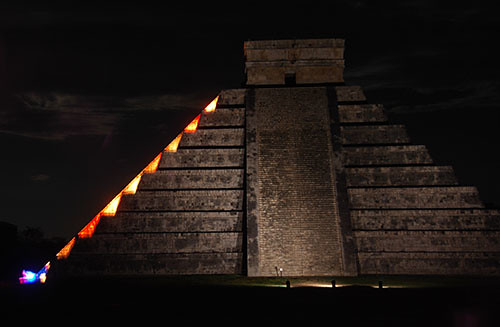I plan to write a series of posts highlighting my favorite archaeological sites. Most I have not had the pleasure to visit but all on my bucket list.
My first post is this series is in honor of everyone I know who will visit the Maya Riviera in the upcoming weeks.
Chichen Itza
The site resides in the northern Yucatan Peninsula and dates to the back to the Late Preclassic (400 BCE to 200 CE), but lasted until the Post-Classic 500 BCE and 1500 CE.
It is one of the largest and most spectacular sites in Mesoamerica, and tourists flock to it each year and in 2007 topped the new list of the Seven Wonders of the World.
The first historical writings that refer to Chichen Itza comes from Fray Diego de Landa who converted many in the Yucatan.
 |
| Excerpt from de Landa's 1579 Relaciones Geográficas, |
Reasons why I love Chichen Itza:
The Sacrificial Cenote
A huge sink well to the north of the site dedicated to the Chac deity who represented rain. The Maya sacrificed artifacts as well as humans.
Diego de Landa described the sacrifices in the cenote in his Relaciones
Geográficas. He writes:
The next most important edifices are those of Tikoch and of Chichén Itzá, which will be described later. Chichén Itzá is finely situated ten leagues from Izamal and eleven from Valladolid, and they tell that it was ruled by three lords, brothers that came to the country from the West. These were very devout, built very handsome temples, and lived unmarried and most honorably. One of them either died or went away, whereupon the others conducted themselves unjustly and wantonly, for which they were put to death. Later on we shall describe the decorations of the main edifice, also telling of the well into which they cast men alive as a sacrifice; and also other precious objects. It is over seven stages down to the water, over a hundred feet across and marvelously cut in the living rock. The water appears green, which they say is caused by the trees that surround it.The Ball-court
The ball-court at Chichen is among the largest in Mesoamerica (the site has 13th one but the largest is in the NW of the site), the field measures 480 feet by 120 feet. The Maya also carved elaborate scenes along the walls of the ball court.
Mesoweb describes the following:
According to Fray Diego Durán's description of the Mesoamerican ballgame as it was played by the Aztecs, it seems to have been a combination of handball and volleyball. Opposing teams faced each other across a center line and volleyed the rubber ball back and forth. They could use only their hips, buttocks and knees to hit the ball (although elbows and forearms may have been allowed in other versions). If it struck the ground, a point was scored for the other team.
Ballplayers used pads and thick clothing to protect themselves from both the hard rubber ball and contact with the ground, which was inevitable given the limitations of what part of the body could make contact with the ball. They also wore leather belts called "yokes" which were often fitted with wood or stone pieces that could be used to keep the ball in play.
The ball could be played on the carom off the walls, and if it happened to pass through one of the stone hoops located high above, the game was over. Evidently the game was played with a great deal of enthusiasm, and players frequently had to have blood drawn from bruises on their thighs and legs.
El Castillo
El Castillo sits in the Great Plaza of the site and has solar references.
- 9 platforms (9 lords of the underworld (Xibalba in Quiche Maya)
- Each set of 9 is divided by 2 by the corners (18 months in Mesoamerican belief)
- 52 panels in the nine terraces (52 years is equivalent to our century in a Mesoamerican Calendar)
- Total steps equal 364, and with the platform there are 365 to equal 365 days
During certain parts of the day, the steps give the pyramid the illusion of a snake descending
This week marks the Spring Equinox, and many will flock to Chichen Itza to celebrate the celestial event.
Other points of interests:
El Caracol (one of the rare round structures in Mesoamerica)
Temple of the warriors (each of the square columns have Toltec warriors carved on them)
Final Thoughts
I hope one day to visit one of the sites I spent 16 years studying, and I also hope this was helpful to anyone wishing to visit Chichen Itza in the near future









No comments:
Post a Comment